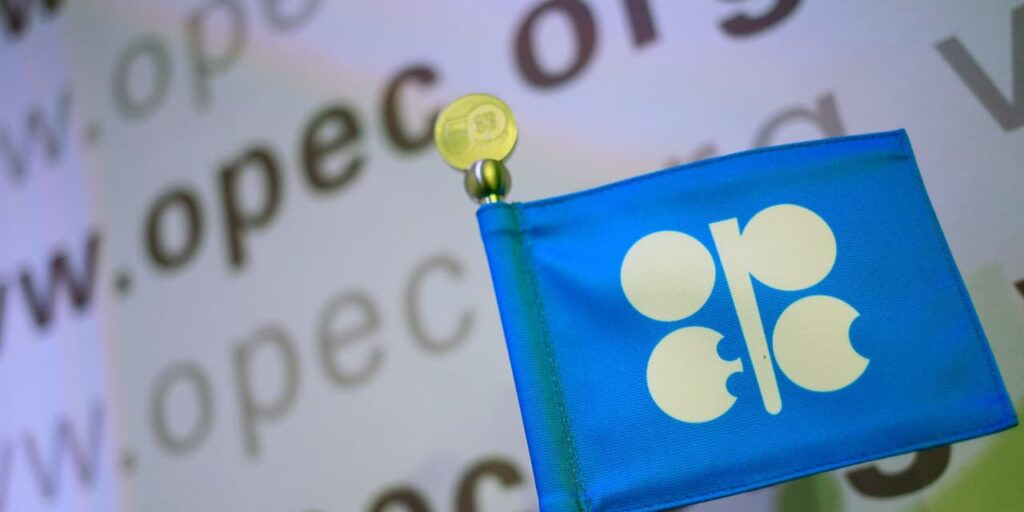Members of the Organization of the Petroleum Exporting Countries and their allies have implemented a number of reductions in oil output since late last year, but crude-oil prices still trade lower as 2023 draws to a close.
In its press release, OPEC+ did not provide a reason for the delay, but Bloomberg reported that the delay came as talks stalled due to Saudi Arabia’s dissatisfaction with production levels among other members.
Key Words: People are just ‘pretending’ oiI demand is weak, says Saudi energy minister. ‘It’s all a ploy.’
Don’t miss: Saudi energy minister Abdulaziz bin Salman Al Saud wins spot in the MarketWatch 50
News of the postponement, and added uncertainty, fueled a decline in oil prices Wednesday. U.S. benchmark West Texas Intermediate crude
CL.1,
CLF24
traded on the New York Mercantile Exchange fell 0.9% at $77.10 a barrel, while global benchmark Brent crude
BRN00,
BRNF24
on ICE Futures Europe settle at $81.96, down 0.6%.
The OPEC+ gathering would come more than seven weeks after the start of the Israel-Hamas war, which led to a temporary rally in oil prices against a backdrop of higher risks for potential spread of the conflict in the oil-rich Middle East.
Key drivers for the year’s oil market have been the global economic outlook, particularly for the major oil consumers of the U.S. and China, and its implications for oil demand, as well as the OPEC+ “supply response in conjunction with the Saudi/Russia voluntary [production] cuts,” Alan Gelder, vice president of refining, chemicals and oil markets at Wood Mackenzie, told MarketWatch.
The Israel-Hamas conflict added about $10 a barrel to oil prices when it started in early October, but that “risk premium has now largely dissipated,” he said. Crude is trading well below levels seen before the start of the war.
Oil prices climbed to intraday highs above $90 a barrel on Oct. 20, following the shock Hamas attack on Israel on Oct. 7 but failed to reach fresh highs for the year. As of Wednesday, WTI crude was down 3.9% to date in 2023, while Brent crude has lost 4.6%.
Forecast failures
“This year is marked by a failure of forecasts,” said Anas Alhajji, an independent energy expert and managing partner at Energy Outlook Advisors.
Russian oil has continued to flow, he said, despite Western sanctions, as well as a price cap on Russian output established by members of the Group of Seven in response to Russia’s invasion of Ukraine in February 2022.
China has not delivered on its expected economic growth, said Alhajji, while the Biden administration failed to fully replenish the Strategic Petroleum Reserve following last year’s historic 180 million–barrel release from the U.S. emergency reserve.
Earlier this month, oil prices fell to their lowest level since July as some economic data pointed to the potential for a slowdown in energy demand.
As the next big decision for OPEC+ nears, it’s hard to see the group agreeing to a fresh production cut, “absent a recession,” said Alhajji. And a cut in the case of a recession would not be intended to raise oil prices, but to “prevent oil prices from declining further,” he said.
Market share
With the U.S. boasting record-high production, the potential loss of market share may be a consideration for OPEC+.
“OPEC+ always monitors the consequences to its market share when it cuts production,” said Wood Mackenzie’s Gelder.
Oil production in the U.S., which is not part of OPEC+, stood at 13.2 million barrels a day for the week ended Nov. 10, holding at a record high, Energy Information Administration data show.
“There is always a trade-off for OPEC between market share and prices,” Jorge León, senior vice president of oil markets research at Rystad Energy, told MarketWatch. Historically, OPEC, or OPEC+, has placed its emphasis on prices, and it’s likely to continue to do so, he said.
However, losing market share is not a key concern for the oil-producer group because U.S. shale is “not as responsive to prices” as it was in the last 2010s, and oil demand remains robust, said León.
OPEC’s monthly oil report released earlier this month forecast 2024 global oil-demand growth of 2.2 million barrels a day.
In a note dated Monday, Helima Croft, head of global commodity strategy at RBC Capital Markets, said the Saudis are not likely to boost output in an effort to regain market share, despite the recent growth in non-OPEC supply.
There has been “background noise” in the market in recent days that Saudi Arabia is poised to phase out its 1 million–barrel daily output cut in January, and that regaining market share is becoming a more important “priority” for the Saudis, Croft said.
Even so, RBC Capital Markets contends that the kingdom “will look to sunset its unilateral reduction when the market is on stronger footing, and their action will not accelerate a stronger move to the downside,” said Croft.
Scenarios
Shortly after news of the OPEC+ meeting delay early Wednesday, CME Group’s OPEC Watch Tool, which calculates the probability of certain potential outcomes for the next OPEC meeting, showed a Nov. 26 outcome probability of 36.75% for no changes to production levels. That was down from 65.88% on Tuesday.
As of Wednesday afternoon, however, the probability of “no change” had shifted to 76.56%, with a 19.42% probability for an output increase, along with a modest 4.02% probability of an output decrease. On Tuesday, there was a 22.59% chance for an output decrease, and a 11.53% probability for an output increase.
Earlier this week, Croft said she expects OPEC+ to “stay the course on existing supply reductions, both collective and unilateral, in order to preserve the floor for prices and prevent a return to 2015 market dynamics.” Oil prices dropped significantly that year amid a glut in crude supplies.
Gelder, meanwhile, also saw a “no change” outcome as the most likely, in comments to MarketWatch ahead of the meeting delay.
Market fundamentals point to moderate price recovery in the fourth quarter and price strength in 2024, he said. Given that, Wood Mackenzie does not expect separate moves by Saudi Arabia and Russia on output, but assumes they’ll continue their current voluntary supply reductions through the first quarter of next year.
At the OPEC+ meeting in June, the group agreed to leave its production cuts in place to the end of 2024, including voluntary cuts of around 1.7 million barrels a day by Saudi Arabia, Russia and other members.
Saudi Arabia then said it would voluntarily reduce its oil production by an additional 1 million barrels a day starting in July, while Russia said it would cut its oil exports by 300,000 barrels a day — with both moves extended to the end of 2023.
A “no change” outcome to the OPEC+ decision, which leaves production at previously agreed levels, and includes continued voluntary Saudi and Russian cuts through the first quarter, would be a “positive outcome for the oil market,” said Gelder.
That “keeps oil-market fundamentals in broad balance,” supporting a modest seasonal stock build during the first quarter and sustaining oil prices at current levels, he said.
Read the full article here













